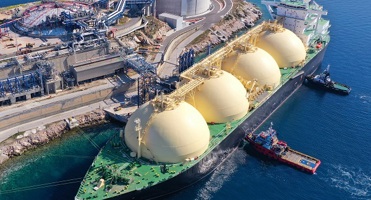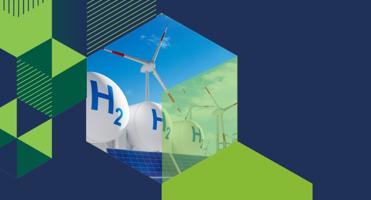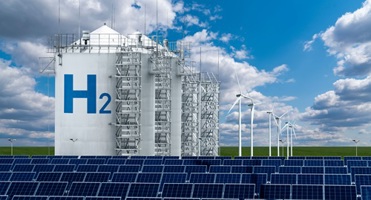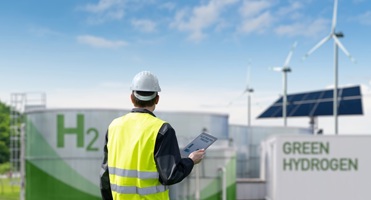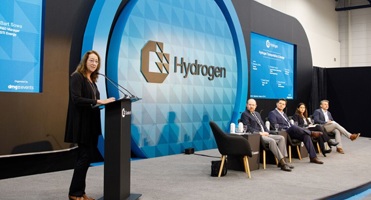Overview
Global hydrogen trade is projected to be worth around USD 30 billion by 2030 – a substantial number, but still relatively small given that greenhouse gases (GHG) continue to rise at a worrying rate – now above ~55 billion tonnes of CO2e p.a. in 2023. The dominant source of such emissions remains energy production (~66% of total GHG emissions), so the emergency really cannot be overstated.
India is actively supporting the development of green hydrogen, investing about $2.5 billion in generation-based incentives and production-linked incentives (PLI) to stimulate local manufacturing of electrolysers. The PLI's success in renewables is notable, and it encourages material investment from developers especially in large-scale projects. Anchoring domestic demand will also be key for India’s energy transition and competitiveness.

Figure 1: Impact of cost of capital on landed Hydrogen cost
* Source : 1) World Bank Group & 2) Alvarez & Marsal – Green Hydrogen India’s Opportunity For A Strategic Shift in Global Energy Trade
Cost of capital and financial structuring
As shown above, the cost of capital is a significant component in the landed cost of green hydrogen. Experienced bankers must apply solid structuring techniques to minimize this cost. Drawing from capital-intensive sectors like LNG, several strategies can help reduce the cost of capital:
- Asset Ownership: Flip ownership of certain assets out of the value chain and apply appropriate risk profiles to attract investment.
- Strongest Covenant: Utilize the strongest covenant in the structure to reduce costs in relevant components of the value chain.
- Project-on-Project Risk: Manage risks within the value chain, dis-aggregating where it makes sense.
- Repayment Flexibility: Incorporate repayment flexibility to accommodate sector volatility especially where contracts are not “utility” in nature.
- Contract Durations: Structure financings to ensure amortization over longer durations even if initial contracts are shorter.
- Contract for Differences (CfD): Use CfD’s for efficiency in the power ecosystem, including the ability to sell excess power.
- Technology Evolution: Capture cost savings from anticipated reductions in electrolysers costs over the next 4-6 years.
If green hydrogen pricing is fixed but with some degree of escalation, lenders would be receptive. If there is a market link to some liquid index, then lenders can also get comfortable but focus on inter alia repayment flexibility. Renewable specialists might handle low-cost green electron production, while others manage midstream and conversion back to ammonia, with shipping likely continuing through leases or charters.
Projects should seek sound financial structuring advice from the outset to attract appropriate capital pools, especially what I term “additionality” capital which will otherwise not qualify if approached late. Early structuring is essential, and good advisers can address issues like contract duration and how to ensure upside from uncontracted sales as well as future expansions. Making these projects a reality is key given the climate emergency. Despite the challenges, collective experience and knowledge will make projects a reality.
Industry Insights
Discussions with industry leaders indicate conviction to establish India in the global low-carbon hydrogen ecosystem. Combining export to markets like the Far East and Europe with the stimulation of local demand can ensure both business and environmental sustainability. India’s ability to move at pace and scale is evident with 180GW of installed renewable capacity already in place and low-cost electrons already achieved despite scope for further indigenisation of the value chain.
Lessons from LNG
There are numerous lessons to be taken from sectors such as LNG which has always had steep capital requirements. After many years of “tramline” operation, the LNG market opened up in the noughties – this was most prompted by the emergence of aggregators who were comfortable not taking back-to-back positions and warehoused volumes often for the purpose of maximising arbitrage. The black-swan event was the shale revolution in the U.S., which fundamentally changed the way LNG was developed, bought and sold.
Green Hydrogen will benefit by being in a position to open up more quickly to hub and spoke type models and the strong green agenda will likely drive the investment in different parts of the value chain at an earlier stage.
Why India is a Match
India stands out for several reasons:
- Hydrogen Strategy: One of only six APAC countries with a hydrogen strategy.
- Government Support: Already deployed USD 2.3 billion in support in various forms.
- Power Grid Ecosystem: Combines wind, solar, and storage to provide round-the-clock power, crucial for green hydrogen production and a unified grid.
- Strong Infrastructure: Developer capacity can enable the needed value chain.
- Low Tariffs: Recent complex renewable auctions have produced tariffs below Rs. 2.5/kWh, benefiting green hydrogen production as green electron costs constitute 65% of hydrogen costs.
For exports, India must demonstrate reliability and security of supply, ensuring sanctity of contracts and timely deliveries, especially to Far-East markets. Round-the-clock power will ensure reliable green-electron production. While the Middle East remains a strong competitor, India is nevertheless well-positioned for green hydrogen development.
Conclusion
The development of green hydrogen in India represents a significant opportunity both for addressing global emissions and fostering economic growth. By leveraging financial structuring expertise, early investment, and government support, India can establish itself as a key player in the global hydrogen market. The combination of domestic demand and export potential makes this an exciting and pivotal moment for India’s energy sector. With the right strategies and support, green hydrogen can be a cornerstone of India’s future. Société Générale looks forward to contributing to India’s emergence as a competitive and reliable green hydrogen supplier.







